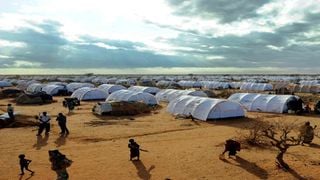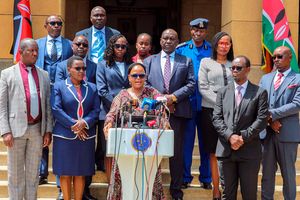
A file photo taken on July 31, 2011, shows Somali refugees walking in the new Ifo-extension at the Dadaab refugee camp in Kenya, the largest refugee camp in the world.
| Tony Karumba | AFPNews
Premium
Kenya sets new date for closure of Dadaab, Kakuma refugee camps
What you need to know:
- Interior CS Fred Matiang’i to hold talks with United Nations High Commissioner for Refugees Filippo Grandi.
- Sources said Kenya will not make further concessions on the closure date.
Kenya wants Dadaab and Kakuma refugee camps closed by June 30 next year, six months earlier than the date proposed by a UN agency’s roadmap.
Kenyan authorities say the two camps, which hold more than 500,000 refugees, a majority of them from Somalia, have been turned into cauldrons of terror and a threat to national security.
Interior Cabinet Secretary Fred Matiang’i will today hold talks with United Nations High Commissioner for Refugees (UNHCR) Filippo Grandi, at which the Kenyan government will request for a roadmap to meet the new deadline that authorities insist is non-negotiable.
Kenya rejected a proposal by UNHCR for the closure of the refugee camps that stretched to December 31 next year, leading to fresh talks with the UN agency’s delegation earlier this week when the new date was communicated.
Interior Principal Secretary Karanja Kibicho also attended the meeting during which the Kenyan government explained to UNHCR why its initial open-ended proposal was unacceptable and stressed Kenya is this time determined to shut down the camps after past efforts failed.
Sources said Kenya will not make further concessions on the closure date, as it had relaxed its initial demand for the camps to be shut down within two weeks from March 23.
At today’s meeting with UNHCR’s top diplomat, the Kenyan government expects “a clear and reasonable breakdown of especially how Somalis, who are the majority, will be repatriated.”
“We are willing to listen to guidance but we must bring this to an end. Refugee camps are not permanent features, they are supposed to be temporary facilities. How can we continue shouldering the burden for three decades?” Dr Matiang’í posed after a past meeting with the UNHCR team.
Volunteered to return home e
And it emerged the repatriation is already underway, with 4,000 Somalis who have volunteered to return home expected to leave on May 5. UNHCR has indicated third countries like United States and Canada have accepted to take in some of the refugees.
However, the UN agency should roughly repatriate 20,000 Somalis monthly over the next 12 months to complete relocation of the 274,299 refugees from the war-torn Horn of Africa nation.
Out of the 512,494 refugees in Kenya, there are 224,462 Somalis in Dadaab and 206,458 in Kakuma.
The two camps have been in operation since 1991, when Somalia plunged into civil war.
Other refugees are 127,412 from South Sudan, DRC (46,024), Ethiopia (29,718), Burundi (17,286), Rwanda (1,917), Eritrea (1,955), Uganda (2,739), Sudan (10,199) and 945 from other nationalities.
Dr Matiang’í has held discussions with ambassadors from these East African countries at which he communicated Kenya’s two options to resolve the crisis.
The refugees from these neighbouring countries have the option of accepting free work permits or returning home.
Foreign Affairs Principal Secretary Macharia Kamau and Kenyan ambassadors to the East African countries also attended the virtual conference.
Kenya is, however, unable to extend similar diplomacy to Somalia after Mogadishu severed diplomatic ties with Nairobi, alleging interference in the Horn of Africa nation’s elections.
Breeding grounds for terrorism
Besides straining resources, Kenya has protested the two sprawling camps pose a threat to security, undermine the nation’s economy through illicit trade and abet environmental degradation.
“The message is that no one will be left in the camps. They have been in operation for three decades and it’s time they were shut down. The camps have become a threat to national security and Kenya has to protect her domestic interests,” said a Kenyan official.
Nairobi says the two camps have been turned into breeding grounds for terrorism, including planning of terror attacks against Kenyans by al-Shabaab militants, who operate from bases in the war-torn neighbouring country.
The refugee economy has involved big money. Between 2016 and the end of last year, UNHCR says it received $549 million (Sh54.9 billion) from the donor community in support of the refugee programme in Kenya.
But Kenya protests it has been left to foot the bills alone, further straining resources.
The Kenyan government has said the international community, including UNHCR, never honoured a pledge to contribute to a kitty to facilitate the repatriation initially agreed in 2013 and thereafter in 2016.
Kenya, which was the only contributor, having put in $10 million (Sh1 billion), says a United Nations camp can be set up in Somalia.
Nairobi has also complained that the world powers have frustrated attempts to have al-Shabaab designated as a terrorist organisation.
The resolution has in the past been shot down at the United Nations Security Council (UNSC), under the argument that doing so would hamper humanitarian work in the war-torn Somalia.
Three terrorist attacks
The urgency to shut down the camps was stressed by three terrorist attacks that claimed the lives of more than 100.
Kenya cited intelligence that terror attacks on Westgate mall in 2013, Lamu’s Mpeketoni in 2014 and Garissa University in 2015 were planned from the camps. In January 2019, al-Shabaab killed more than 20 people following an attack on the DusitD2 complex in the Westlands area of Nairobi.
Further, Nairobi says proceeds from the contraband trade including smuggling of sugar from Somalia into Kenya have been used to finance al-Shabaab operations.
President Uhuru Kenyatta’s government had initially agreed on the repatriation in November 2013 with Somalia and the UNHCR, which would have seen the refugees return home over a three-year period.
However, only 14,000 had been repatriated by April 2016 and the following month Kenya set another timeline for the closure of the Dadaab refugee complex, by November 30, 2016.
The government is this time determined to see to it that the refugees are all repatriated within the next four months.
Kenyan officials have denied the decision to shut down the refugee camps had anything to do with the maritime boundary case with Somalia, arguing the repatriation process started in 2016, before the dispute had been filed at the International Court of Justice.





